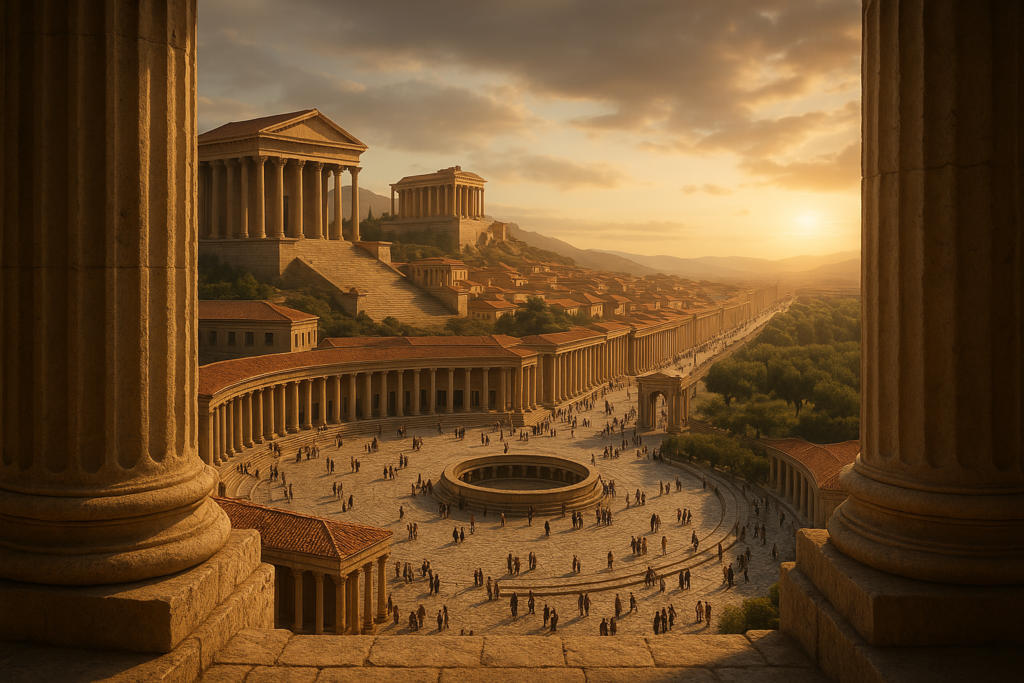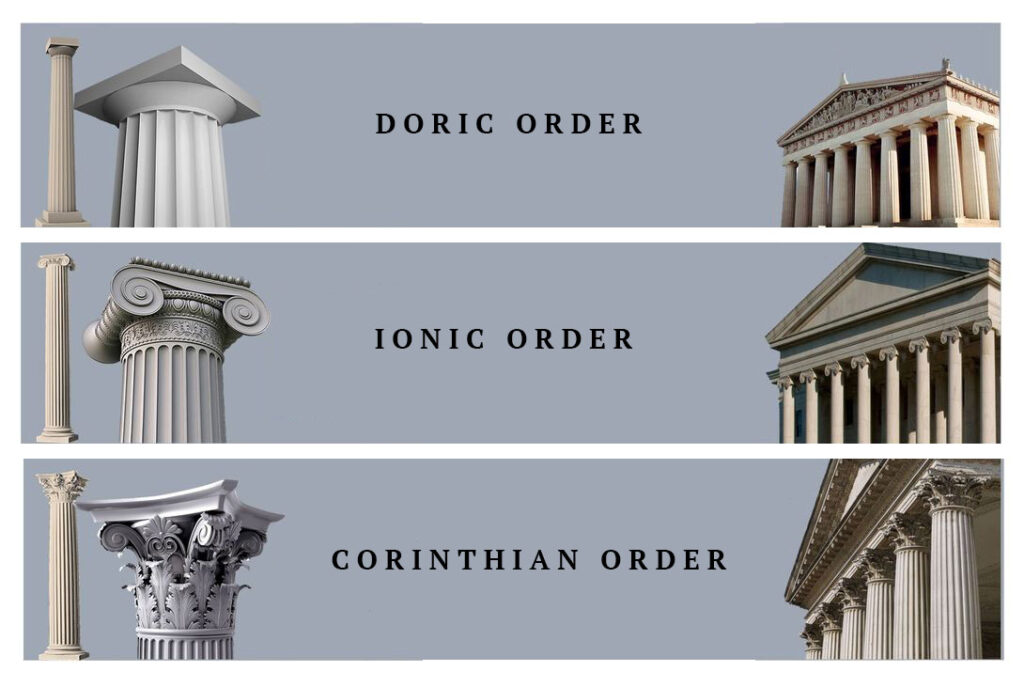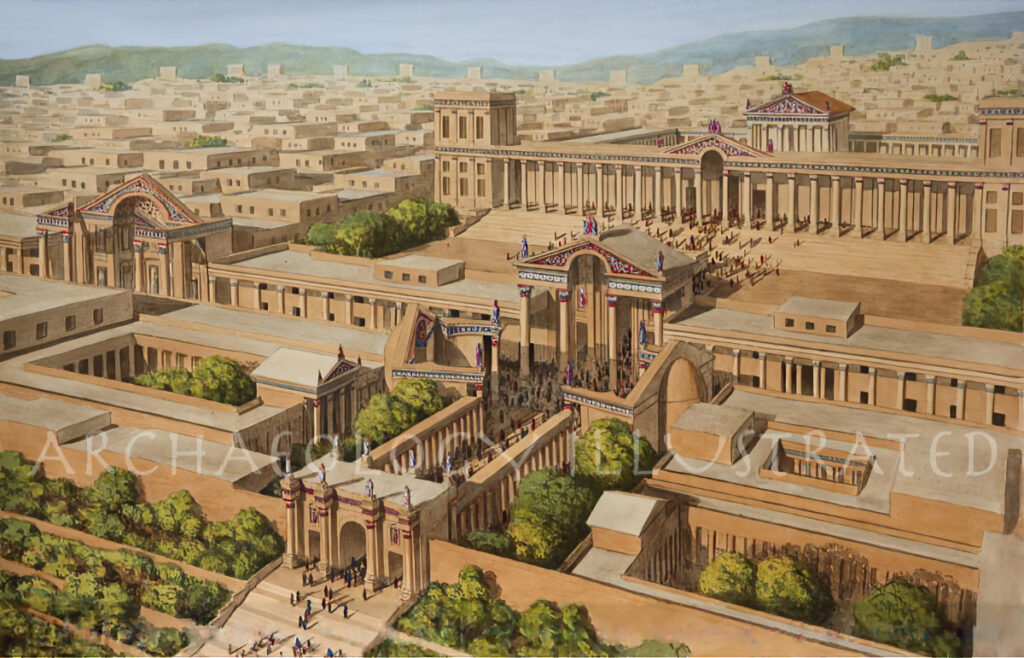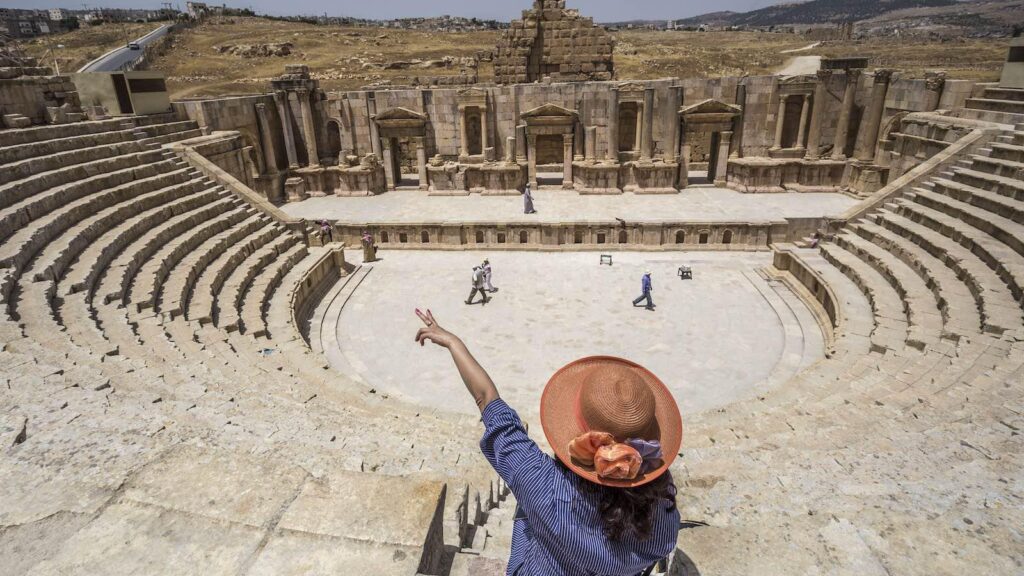This is the first article of my series on the region of Decapolis and the ancient city of Gerasa.
Note: This article combines archaeological and historical evidence spanning from Gerasa’s early development through the 2nd century AD to present a comprehensive picture of the city’s geographical setting.

Picture yourself in the first century AD, standing atop one of Gerasa’s hills. Below you, a city thrives with its grand temples, bustling markets, and colonnaded streets. This is just one of the ten remarkable cities that formed the Decapolis – a group of self-governing cities that flourished under Rome’s protective influence while maintaining their own unique identity and independence.
A Unique Partnership

The Decapolis wasn’t a formal league or confederation, but rather a group of ten cities that shared cultural and commercial bonds while maintaining their individual autonomy. Unlike other regions directly governed by Rome, these cities enjoyed a special status that allowed them to mint their own coins, establish their own laws, and manage their own affairs while benefiting from Rome’s protection and trade networks.
The ten cities included:
- Gerasa (modern-day Jerash, Jordan)
- Philadelphia (modern-day Amman, Jordan)
- Damascus (Syria)
- Gadara (Umm Qais, Jordan)
- Pella (Tabaqat Fahl, Jordan)
- Scythopolis (Beth Shean, Israel)
- Hippos (Sussita, Israel)
- Dion (location debated)
- Raphana (location debated)
- Canatha (Qanawat, Syria)
Power and Politics

Each Decapolis city operated as a self-governing entity with its own council (boule) and assembly (ekklesia). Local magistrates, often from prominent families, managed civic affairs while maintaining diplomatic relationships with both Rome and neighboring regions. This careful balance allowed the cities to prosper while serving as stable centers of commerce and culture.
These cities demonstrated their autonomy through:
- Minting their own coins
- Maintaining their own laws and civic institutions
- Collecting local taxes for city development and maintenance
- Conducting independent diplomatic relations
- Preserving local customs and traditions
While these cities maintained significant financial independence in managing their local affairs and collecting civic taxes, they were still required to pay tribute to Rome as part of their relationship with the empire. This tribute was separate from their local tax system and represented their acknowledgment of Rome’s protection rather than direct Roman governance.
Cultural Identity: Between East and West


What made the Decapolis truly remarkable was its unique cultural fusion. While these cities embraced Hellenistic architecture and institutions, they weren’t simply Greek cities transplanted to the East. Instead, they developed their own distinct identity that combined Greco-Roman influences with deep-rooted Semitic traditions.
The upper classes spoke Greek and participated in Greek-style civic life, while many citizens maintained their Aramaic language and local customs. This wasn’t a source of conflict but rather a testament to the cities’ ability to embrace multiple cultural traditions while maintaining social harmony.
Commerce: The Lifeblood of Independence

The Decapolis cities’ autonomy was built on a foundation of economic strength. Positioned along crucial trade routes, these cities served as vital commercial hubs linking the Mediterranean world with the Arabian Peninsula and lands further east. Their markets echoed with multiple languages as merchants traded in:
- Spices from Arabia
- Silks from China
- Pottery from local craftsmen
- Olive oil from surrounding agricultural lands
- Textiles from various regions
This economic prosperity allowed them to maintain their independence while contributing to the broader Roman economic network.
Religion and Society

Religious freedom was another hallmark of Decapolis autonomy. While impressive temples to Greco-Roman deities dominated the skylines, these cities were home to diverse religious practices. Jewish communities maintained their traditions, local cults continued to thrive, and the early Christian movement found fertile ground here.
This religious diversity reflected the Decapolis cities’ broader approach to governance – maintaining order while allowing various communities to preserve their traditions and beliefs.
Daily Life Under Self-Rule

Life in a Decapolis city offered opportunities unknown in many other parts of the Roman world. Citizens could:
- Participate in local government
- Practice their chosen religion freely
- Conduct business under stable local laws
- Enjoy both Greek and local entertainments
- Maintain their cultural traditions while adopting new ones
Legacy of Independence

The archaeological remains of Decapolis cities, particularly the extensive ruins of Gerasa, stand as testament to what autonomous cities could achieve under Rome’s protective influence. Their success demonstrates how independence and security could coexist, creating prosperous urban centers that preserved local identity while benefiting from connection to a larger empire.
Disclaimer:
All images used on this article are the property of their respective owners. I do not claim ownership of any images and provide proper attribution and links to the original sources when applicable. If you are the owner of an image, please contact us so I can add your information or remove it if you wish.
Sources:
- “Official Guide to Jerash” with plan by Gerald Lankester
- “The Chora of Gerasa Jerash” by Achim Lichtenberger and Rubina Raja
- “Jarash Hinterland Survey” by David Kennedy and Fiona Baker
- “Antioch on the Chrysorrhoas Formerly Called Gerasa” by Achim Lichtenberger and Rubina Raja
- “Jarash Hinterland Survey — 2005 and 2008” by David Kennedy and Fiona Baker
- “A new inscribed amulet from Gerasa (Jerash)” by Richard L. Gordon, Achim Lichtenberger and Rubina Raja
- “Apollo and Artemis in the Decapolis” by Asher Ovadiah and Sonia Mucznik
- “Onomastique et présence Romaine à Gerasa” by Pierre-Louis Gatier
- “Dédicaces de statues “porte-flambeaux” (δαιδοῦχοι) à Gerasa (Jerash, Jordanie)” by Sandrine Agusta-Boularot and Jacques Seigne
- “Un exceptionnel document d’architecture à Gérasa (Jérash, Jordanie)” by Pierre-Louis Gatier and Jacques Seigne
- “Zeus in the Decapolis” by Asher Ovadiah and Sonia Mucznik
- “The Great Eastern Baths at Gerasa Jarash” by Thomas Lepaon and Thomas Maria Weber-Karyotakis
- “Architectural Elements Wall Paintings and Mosaics” by Achim Lichtenberger
- “Glass Lamps and Jerash Bowls” by Rubina Raja
- “Water Management in Gerasa and its Hinterland” by David D. Boyer
- “Hellenistic and Roman Gerasa” by Rubina Raja